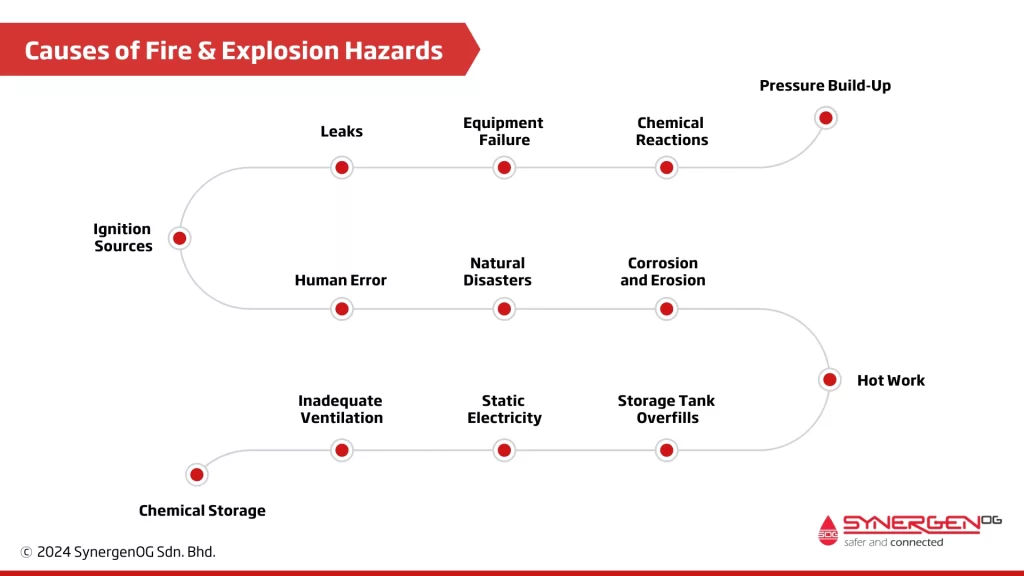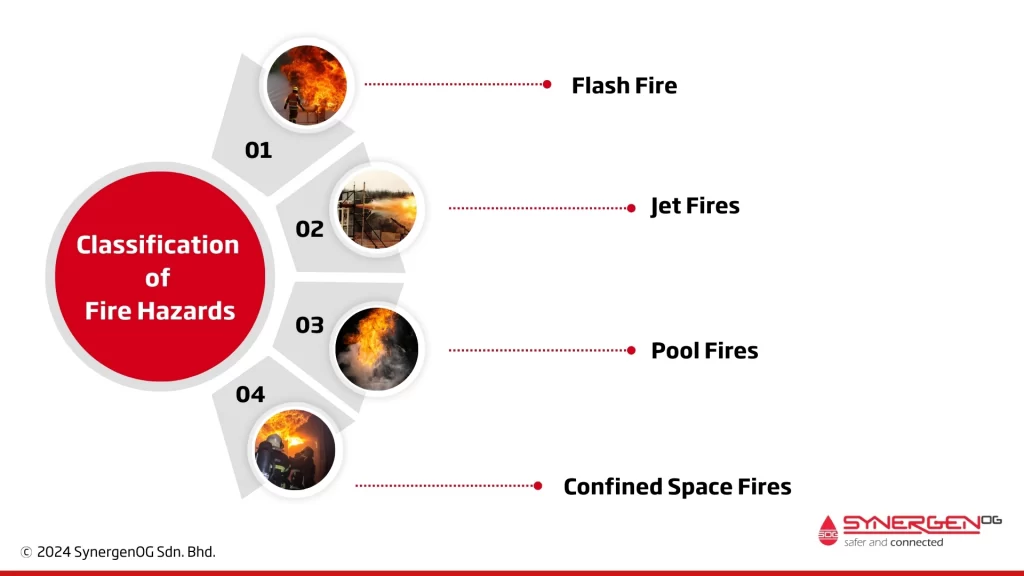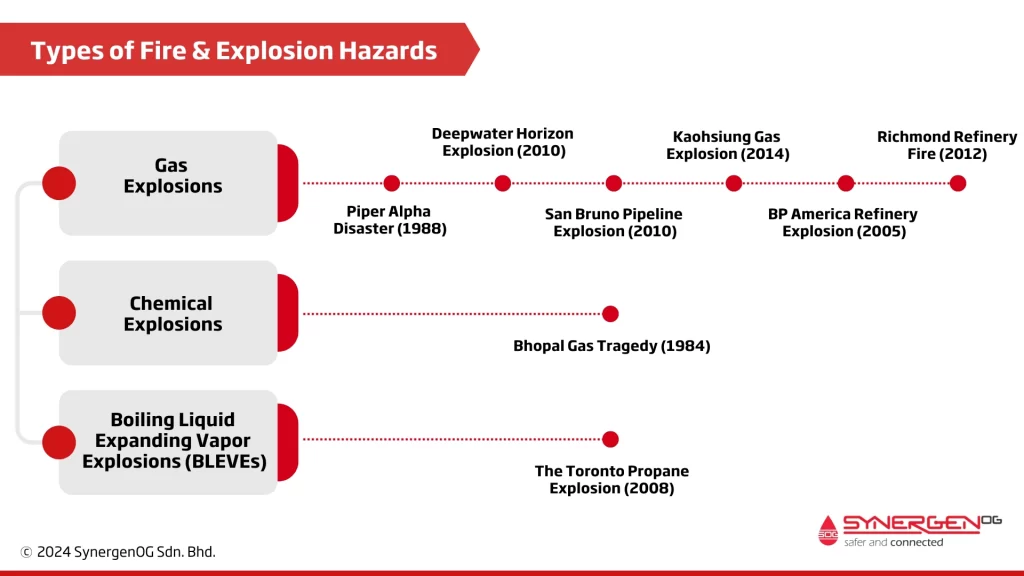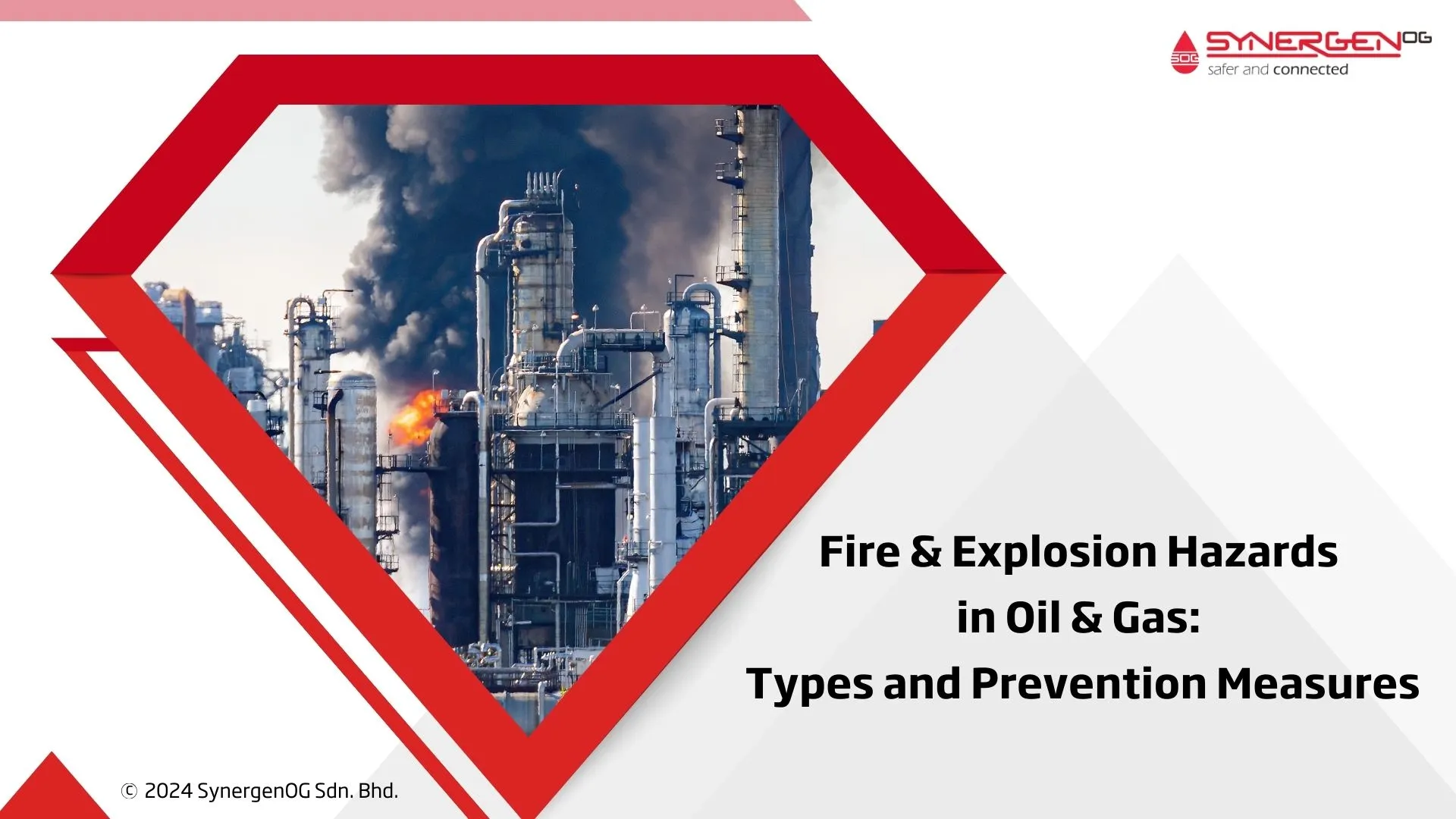| Summary: Discover the types, causes, and impact of fire and explosion hazards in the oil and gas industry. Find the different categories of fire explosions being the cause of fatal incidents in the past. Learn how to prevent accidents and protect personnel, equipment, and the environment. |
One of the most serious dangers workers face in the oil and gas industry is the risk of fires and explosions. These incidents can endanger workers, facilities, and the environment. It is essential to have a clear understanding of the different types of fire and explosion hazards to maintain safety and reduce risks throughout all operational stages, including exploration, drilling, refining, and transportation.

Fires and explosions in the Oil and Gas industry are often caused by,
- Pressure Build-Up: High-pressure environments within pipelines, storage tanks, and processing facilities can result in explosions if not properly managed.
- Chemical Reactions: Chemical reactions between different substances or materials can generate heat and pressure, potentially leading to explosions.
- Equipment Failure: Malfunctioning equipment, such as valves, pumps, and compressors, can release flammable materials or create ignition sources.
- Leaks: Leaks in pipelines, valves, or storage tanks can release flammable gases or liquids, which may ignite upon contact with an ignition source.
- Ignition Sources: Sparks, open flames, hot surfaces, electrical equipment, and static electricity can all serve as ignition sources in hazardous environments.
- Human Error: Mistakes in handling equipment, improper maintenance procedures, and failure to follow safety protocols can increase the risk of accidents.
- Natural Disasters: Events such as earthquakes, hurricanes, and floods can damage infrastructure and disrupt operations, leading to potential fire and explosion hazards.
- Corrosion and Erosion: Corrosion and erosion of equipment and pipelines can weaken structural integrity, increasing the likelihood of leaks and failures.
- Hot Work: Welding, cutting, and other hot work activities can produce sparks and heat, posing a risk of igniting nearby flammable materials.
- Storage Tank Overfills: Overfilling of storage tanks can result in spills and releases of flammable liquids, which may ignite and cause explosions.
- Static Electricity: Static electricity buildup, especially in dry or low-humidity environments, can discharge and ignite flammable gases or vapors.
- Inadequate Ventilation: Poor ventilation in confined spaces or enclosed areas can allow flammable gases to accumulate, increasing the risk of ignition.
- Chemical Storage: Improper storage of hazardous chemicals or materials can lead to spills, leaks, and potential fire and explosion hazards.
Classification of Fire Hazards – Related to Material & Condition

In the oil and gas sector, fires can be categorized based on the materials involved and the conditions under which they ignite. Here are the primary types of fires encountered in the oil and gas industry,
1. Flash Fire
A flash fire is a rapid flame propagation through a diffused fuel, such as natural gas or vaporized liquid hydrocarbons, which can occur in the open or a semi-enclosed area.
These fires are characterized by their short duration, typically lasting less than three seconds, but they generate intense heat and potentially fatal burns.
2. Jet Fires
Jet fires result from the high-velocity discharge of flammable gas or liquid through an orifice or leak, creating a long, narrow flame.
These fires pose significant risks due to their high heat output and potential for causing structural damage, especially to piping and containment systems.
3. Pool Fires
Pool fires occur when flammable liquids spill from containment and ignite, forming a fire that burns over the liquid surface.
These fires can spread rapidly, especially if the liquid flows over a large area, and produce a significant amount of radiant heat, posing a threat to personnel and equipment.
4. Confined Space Fires
Fires in confined spaces, such as tanks or vessels, are particularly hazardous due to the limited access to firefighting and the potential for accumulation of flammable vapors.
These fires can lead to explosions if the pressure within the confined space increases rapidly.
Read: Fire and Explosion Risks: Incorporating Consequence Modelling
Types of Fire & Explosion Hazards in the Oil & Gas Industry

Gas Explosions
Gas explosions are perhaps the most common type of explosion in the oil and gas sector. These occur when flammable gases like methane come into contact with an ignition source. Such incidents can be traced back to leaks in pipelines, malfunctioning equipment, or inadequate ventilation systems. It is not uncommon for gas explosions to result in escalation which is release of more hydrocarbon inventory resulting in gas and liquid fires or another explosion.
Here are some notable incidents due to gas explosions,
1) Piper Alpha Disaster (1988)
The Piper Alpha disaster in the North Sea is one of the deadliest gas explosion incidents in the history of the oil industry.
Cause: A gas leak following maintenance failures, where a safety valve was removed but not replaced, leading to gas escape and ignition. Inadequate communication between shifts compounded the error, resulting in a catastrophic explosion and fire.
Impact: Death of 167 workers.
2) Deepwater Horizon Explosion (2010)
The Deepwater Horizon oil spill, one of the most infamous environmental disasters, began with a gas explosion on an offshore drilling rig in the Gulf of Mexico.
Cause: A series of failures in safety measures, equipment maintenance, and emergency response, highlighting the critical need for stringent safety protocols and regular equipment checks to prevent gas leaks and explosions.
Impact: Death of 11 workers and millions of barrels of oil spill into the ocean over 87 days.
3) San Bruno Pipeline Explosion (2010)
The San Bruno pipeline explosion occurred in a suburban area near San Francisco, California, when a natural gas pipeline ruptured and ignited.
Cause: The pipeline’s poor maintenance, coupled with inadequate regulatory oversight, contributed to the disaster.
Impact: 8 deaths
4) Kaohsiung Gas Explosion (2014)
In Kaohsiung, Taiwan, a series of underground gas explosions caused massive damage to roads and buildings.
Cause: The explosions were attributed to leaks from improperly maintained underground pipelines.
Impact: 32 deaths and more than 300 injuries
5) BP America Refinery Explosion (2005)
In the BP America Refinery Explosion, the explosion was primarily attributed to the release and ignition of hydrocarbon vapor and liquid. This incident was caused by a series of failures that led to the release of hydrocarbons, which are highly flammable and can create explosive mixtures when combined with air under the right conditions.
Cause: The incident was caused by the release of hydrocarbon vapor and liquid from a distillation tower during the startup of an isomerization unit. The released hydrocarbons formed a vapor cloud that ignited.
Impact: 15 deaths, over 170 injuries
6) Richmond Refinery Fire (2012)
At Chevron’s refinery in Richmond, California, a vapor cloud ignited after a corroded pipe leaked flammable hydrocarbons. The incident highlighted issues with corrosion management and emergency response protocols.
Cause: The accident was caused by a leak in a corroded pipe within a crude oil processing unit, leading to the release and ignition of hydrocarbon gases that resulted in a massive fire. Despite prior identification of the pipe’s corrosion, it was not replaced during maintenance, causing a massive fire that produced a plume of black smoke visible for miles.
Impact: 19 workers were endangered, significant health impacts to 15,000 residents due to smoke and pollutants.
Preventive Actions for Gas Explosions
The key to preventing these explosions is regular monitoring for gas leaks, proper maintenance of equipment, and ensuring that areas prone to gas accumulation are well-ventilated.
Chemical Explosions
Explosions can result from the reaction of incompatible chemicals, over-pressurization of containers, or decomposition of unstable compounds.
Bhopal Gas Tragedy (1984)
The Bhopal Gas Tragedy, which happened in 1984, in Bhopal, India is a harrowing example of industrial negligence with profound human and environmental impacts.
Cause: The immediate cause of the disaster was water ingress into a storage tank containing 42 tons of Methyl Isocyanate (MIC) at the Union Carbide India Limited (UCIL) pesticide plant in Bhopal, India. This contact triggered an exothermic reaction, increasing the pressure within the tank and releasing a large cloud of MIC gas over the city of Bhopal.
Impact: Immediate death of around 2,259 people, followed by 8,000 1-2 weeks after. Approximately 16,000 have died since the incident from gas-related diseases. Over 500,000 suffer from health issues including respiratory difficulties, eye irritation, and systemic injuries.
Preventive Actions for Chemical Explosions
Proper chemical storage, correct labeling, and worker training on chemical handling, improving process controls, and developing comprehensive emergency response plans.
Boiling Liquid Expanding Vapor Explosions (BLEVEs)
A BLEVE happens when a container holding a pressurized liquid above its boiling point ruptures, often as a result of exposure to fire. This leads to a rapid phase change from liquid to gas, resulting in an explosion.
BLEVEs are particularly dangerous because of their ability to project debris at high velocities and generate large shockwaves. In oil and gas industry, BLEVEs are a concern for storage tanks and transport vessels containing liquefied gases.
The Toronto Propane Explosion (2008)
This incident occurred at the Sunrise Propane Industrial Gases propane facility in Toronto, Canada, on August 10, 2008, a notable example of a Boiling Liquid Expanding Vapor Explosion (BLEVE).
Cause: The explosion was triggered by a leak of propane gas during an illegal truck-to-truck transfer in the early hours of the morning. The gas found an ignition source, leading to a series of explosions, with the largest being classified as a BLEVE. The overheating of propane tanks caused them to rupture, releasing a massive vapor cloud that ignited.
Impact: Death of 1 employee, 12,000 residents evacuated, extensive environmental clean up, and significant damage to the facility and surrounding area.
Preventive Actions for BLEVEs
Regular inspection and maintenance of pressure vessels, along with effective fire protection and pressure relief systems, are key to preventing BLEVEs.
Also Read: Process Safety Incidents
Conclusion
The oil and gas industry plays an important role in our world, but it’s not without its dangers. Fire explosion hazards are a significant risk, but with proper understanding, precautions, and safety measures, these risks can be significantly reduced. It’s about creating a culture of safety that prioritizes the well-being of workers, the community, and the environment.
FAQ - Fire & Explosion Hazards
- What are the consequences of unignited gas releases?
Consequences of an unignited gas release is asphyxiation and exposure to toxic gas (if the released gas is toxic) resulting in potential onsite and offsite fatalities.
- What are the consequences of gas explosions?
Consequences of gas explosions include shockwaves, shrapnel, fires posing an immediate danger to life and property.
- What are the consequences of oil fires?
Consequences of oil fires include potential fatalities due to thermal radiation, asphyxiation or smoke inhalation, environmental pollution, and the risk of the fire spreading to surrounding areas.
- What are the consequences of gas fires?
Consequences of gas fires include potential fatalities due to thermal radiation and equipment or structural damage.
- What is fire and explosion in the Oil and Gas industry?
Fire and explosion in the oil and gas refers to the ignition of flammable gases or liquids, leading to rapid combustion or violent expansion that can cause significant damage and injuries.
- What are the risks in the Oil and Gas industry?
One of the biggest risks in the oil and gas industry is fires, explosions or toxic gas releases from the handling and processing of hydrocarbon fluids. The risks are fatalities, asset loss, environmental damage, and financial and reputation losses.
- What are the hazardous gases in Oil and Gas?
Hazardous gases in the oil and gas industry include hydrogen sulfide (H2S), methane (CH4), volatile organic compounds (VOCs), and carbon monoxide (CO).



[…] Fire and Explosions […]
[…] collected data against safety standards to pinpoint hazards, risks, and system weaknesses. This phase demands impartiality and comprehensive […]